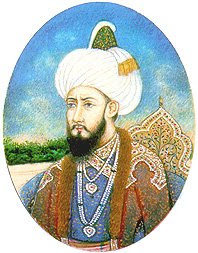
Almost 500 years ago, Karnawati had sent a 'rakhi' to Emperor Humayun and sought his help when her kingdom was besieged by the enemy forces.
Humayun left Delhi and reached Chittaur in keeping with the age-old tradition of Raksha Bandhan.
The attacker Bahadaur Shah Gujrati had annexed Malwa in 1531 AD and was marching on. As his forces surrounded the fort of Chittor, Rani Karnavati, the Raja's mother, appealed to Badshah--the mughal king Humayun for help.
Along with her letter, she sent 'rakhi', the sacred thread that girls tie on the wrists of their brothers and in turn they pledge to take care of them.
Humayun left Delhi and reached Chittaur in keeping with the age-old tradition of Raksha Bandhan.
The attacker Bahadaur Shah Gujrati had annexed Malwa in 1531 AD and was marching on. As his forces surrounded the fort of Chittor, Rani Karnavati, the Raja's mother, appealed to Badshah--the mughal king Humayun for help.
Along with her letter, she sent 'rakhi', the sacred thread that girls tie on the wrists of their brothers and in turn they pledge to take care of them.
Humayun accepted the 'rakhi' and proceeded to Chittor though Bahadur Shah didn't expect the Emperor to rush to Chittor and fight him.
Humayun did reach Chittor and Bahadur Shah had to flee. He escaped to Malwa but Humayun followed him to Fort Mandu and later on to Champanir where he took refuge.
Though Humayun had got delayed in starting off, he did honour this tradition and taught a lesson to the aggressor.
Even historians with a Saffron bent don't dispute this occurrence, as it is no myth and is recorded in history. Isn't it strange that so little we hear about this episode these days.
While the myths (and truths) regarding Muslim kings' persecution of other community are blown up all the time, such aspects are ignored.
Such glorious aspects of Indian history that are shining examples of the composite culture need to be highlighted. And this is just an example. In fact, in countless homes across the country, Hindus sisters tie rakhi to Muslim brothers and there are also Muslim girls who tie rakhin on the wrists of Hindu brothers.
Even historians with a Saffron bent don't dispute this occurrence, as it is no myth and is recorded in history. Isn't it strange that so little we hear about this episode these days.
While the myths (and truths) regarding Muslim kings' persecution of other community are blown up all the time, such aspects are ignored.
Such glorious aspects of Indian history that are shining examples of the composite culture need to be highlighted. And this is just an example. In fact, in countless homes across the country, Hindus sisters tie rakhi to Muslim brothers and there are also Muslim girls who tie rakhin on the wrists of Hindu brothers.























